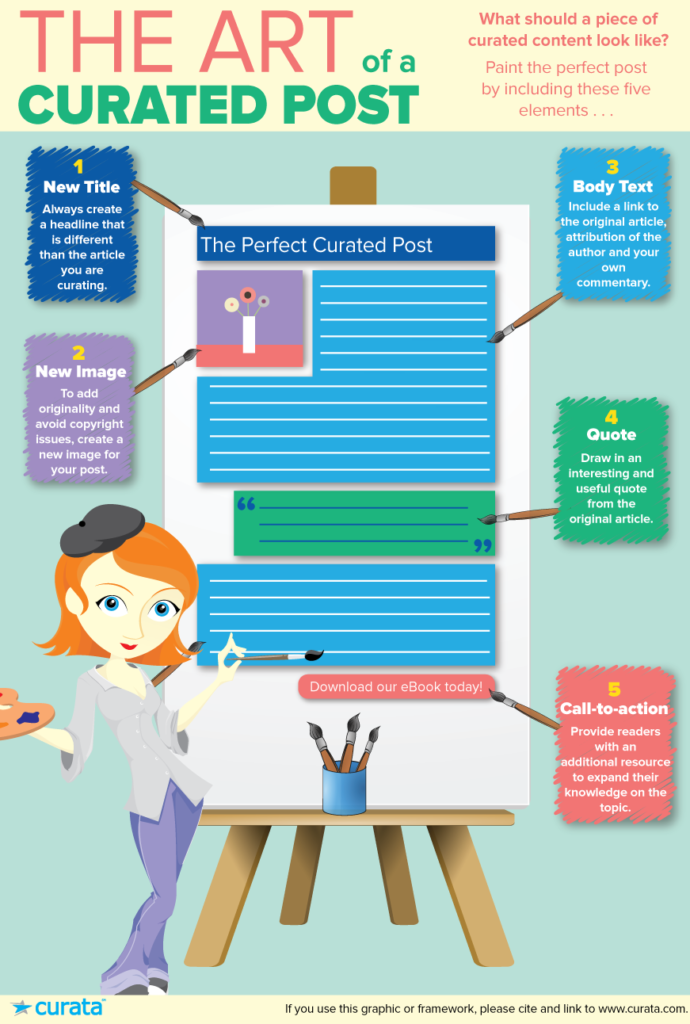
As a B2B business, lead generation is one of your key concerns. After all, without enough lead generation, you’ll have a tough time bringing in enough new clients on board to generate consistent revenue.
While making your own content to fill your business blog and social media pages is important, it’s also crucial to practice smart, effective content curation. Today, let’s break down what content curation is and how you can leverage it to improve B2B lead generation across the board.
What is Content Curation?
Put simply, content curation is the art and science of collecting and spreading content relevant to your industry or brand to your target audience members. It is contrasted with standard content creation.
With content creation, you make content, like a blog post or product review, that you then post to your brand website or social media pages. Your audience reads that content and walks away with value or with a good idea of the authority your brand has in its niche or industry.

Content curation is different. You don’t create your own original content; you instead find content from other trusted sources and bring it together on your platform of choice. The advantage? You can offer your audience value and information from a much bigger range of sources than just yourself, and much more quickly.
Of course, content curation is not stealing, let alone illegal in any fashion! Think of content curation as offering additional value to your key consumers or target audience members beyond what you can whip up from scratch for marketing purposes.
Why Content Curation Matters for B2B Lead Generation
Content curation matters a great deal for B2B lead generation, and there’s a big reason why: authority and trust.
When it comes to generating leads and marketing in general for B2B or business-to-business brands, you have to focus more on proving your authority or providing real, actionable value to your clients and consumers. B2B clients aren’t often focused on entertainment – they want to know that your brand can provide them with real solutions or practical fixes to their pain points.
Content curation can help a lot with B2B lead generation because of this. For example, say that you run a brand offering software-as-a-service solutions to companies. To that end, you might collect and curate content like:
- Scientific studies proving one of your claims
- Reviews of your products or services from trusted third parties or sources
- Explorations of niche, relevant topics to your industry
- And more
All of that content can do wonders for maximizing your brand authority and making it seem like a surefire choice for your target clients. In many ways, content curation matters for B2B lead generation because it provides some initial value to your target clients in a way that “standard” marketing may not.
Plus, curated content by definition is content you did not create. So any reviews, takeaways, or value provided by that content might hold inherent value to your target customers compared to content that you make (which is necessarily biased toward your brand).
How to Use Content Curation to Improve Lead Generation
Good news – you can use content curation to improve B2B lead generation in a variety of ways. Let’s break down how you can use content curation effectively and successfully right from the get-go.
Prioritize the Needs/Wants of Your Audience
First, you should consider the unique needs of your B2B audience or target client group. Generally, B2B clients want informative, educational content rather than flatly entertaining content, like “listicles.”
To that end, you should prioritize curating content including but not limited to:
- Professional papers and reviews
- Discussions about key topics in your industry by industry experts
- Educational content about your industry or a fact within your niche
- And more
If you give your target clients content that they want to see in your curated lists, they’ll be more likely to pay attention to each new round of content you produce, whether it’s on your website or a social media profile.
Curate Different Types of Content
Furthermore, you’ll want to curate different types of content, not just blog posts.

In fact, for the most effective content curation for B2B clients, you should collect and post content like:
- Longform blog posts
- Video content
- Social media posts and thoughts
- Roundup posts
- User-generated content, such as review videos or testimonials
- Discussions and forum threads
- And more
The more varied your content curation is, the more valuable it will be to anyone reading it. Plus, your content will appear to be sourced with more effort and thought on your part – always a good thing when you are trying to convince new B2B clients to give your brand a shot. This is a highly important tip to remember when scoring leads.
Share from More Than One Source/Website
By the same token, you should share and curate content from more than one source or website. If most of your curated content comes from a single source or site, people reading it might think that the site is partnered with you. They could suspect your two websites to be sharing leads or traffic, which can diminish your authority and the value of your content curation efforts in the first place.
Try to spread out your content collection across as wide a range as possible. This is easier with larger industries with a lot of content creation each month, but it’s something you should attempt regardless of your niche.
Give Opinions – Share Your Voice
Good content curation doesn’t just mean rounding up posts or videos from competitors and other sites in your industry. It means commenting on them and sharing your voice or opinion.
As a marketer or business executive, you should present your brand’s thoughts on a lot of the content you curate for your audience. For example, if you highlight a blog post by a competing organization, it’s not a bad thing to comment on it or start a discussion on your social media page.
Not only does this do wonders to increase engagement with your brand, but it also helps to highlight the authority of your business and prove that you are to be trusted in its niche.
Track Performance and Engagement Levels
Lastly, don’t forget to continually track the performance and engagement levels of your curated content. If certain types of curated content do better or generate more comments and discussions, for example, that’s a sign that you can lean into those content pieces more often.
Give the people what they want! There’s no reason to focus on poor-performing content if it doesn’t get a lot of traffic or lead generation. Regular analysis and monitoring of your content are key to ensuring you get new leads consistently.
Wrap Up
As you can see, content curation is a key component of B2B success for your brand and others. Fortunately, you don’t have to jump into this aspect of marketing with no help at all. In fact, you can rely on trusted experts to take care of all your curation work for you.
Enter Scoop.it. Our comprehensive, intuitive platform helps businesses just like yours to curate, share, and spread content on social media pages and elsewhere. With our assistance, you’ll immediately get a jumpstart on effective B2B content curation, maximizing lead generation and improving revenue in more ways than one.
Want to get started? Contact us today to get started with a free demo.


 (1 votes, average: 4.00 out of 5)
(1 votes, average: 4.00 out of 5)